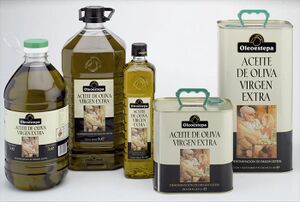
Description
Estepa is Spanish DOP extra virgin olive oil obtained from the fruit of the following varieties of olive (Olea Europea L.), there being three types of extra virgin olive oil:
Hojiblanca, Arbequina, Manzanilla, Picual and Lechín de Sevilla
This oil is made from at least 50 % of extra virgin olive oil of the Hojiblanca variety, between 20 and 30 % of the Arbequina variety and up to 5 % of the other varieties (Manzanilla, Picual and Lechin de Sevilla). This type of oil has the fruitiness of green rather than ripe olives with a medium intensity. It has the bitterness and spiciness characteristic of oils obtained at the beginning of the season.
Hojiblanca and Arbequina
This oil is made from between 40 and 60 % of extra virgin olive oil of the Hojiblanca variety and between 40 and 60 % of the Arbequina variety.
This type of oil has aromas and flavours of fresh and/or ripe fruits and the fruitiness of from green to semi-ripe olives. It has the bitterness and spiciness characteristic of oils obtained at the beginning of the season.
Hojiblanca
This oil is 100 % extra virgin olive oil of the Hojiblanca variety. This type of oil has aromas and flavours of fresh and/or ripe fruits and fresh grass and the fruitiness of green olives. It has the bitterness and spiciness characteristic of oils obtained at the beginning of the season.
Geographical area
The area covers 11 municipalities in the Province of Seville: Aguadulce, Badolatosa, Casariche, Estepa, Gilena, Herrera, Lora de Estepa, Marinaleda, Pedrera, La Roda de Andalucía and El Rubio, and one municipality in the Province of Córdoba: Puente Genil, specifically the area known as Miragenil.
Method of production
Most of the groves are planted 12 × 12 in the traditional, staggered pattern. New intensive groves have much higher densities and therefore much smaller planting patterns. Fertilisation is carried out in winter, after the harvest. More intensively planted groves have generally led to an increase in irrigation. Irrigation systems are in almost all cases localised systems. The shape of the olive trees is a result of the types of pruning used, known as goblet pruning and rational pruning, which involve removing large cuts of wood from the trunk. The authorised plant-health products must not harm useful fauna and leave no residues in the olives.
The olives are harvested with care directly from the tree using the traditional methods of beating with poles, hand picking or vibration. The fruit is always transported in bulk in trailers or rigid containers. The olives are then pressed at registered mills within 24 hours of harvesting. Preparation involves the following stages: cleaning and washing the olives; pressing; beating the paste; phase separation; decantation; storage in tanks until packing; transportation in bulk and packing.
Link to the geographic area
A large number of olive groves are planted on limey soil, a soil that, by its action on the trees, is better at preventing them taking up iron. The soil is also much better at retaining water, which means that during dry periods plantations on this type of soil are moister. This creates a particular type of grove with its own characteristics and hence oils that are clearly different and characteristic.
Studies show that this type of soil promotes a higher concentration of antioxidants that are of particular interest from the point of view of nutrition, i.e. tocopherols, and particularly α-tocopherol, which is present in higher proportions (> 95 %). Another factor that influences the characteristics of the oils is the local climate, in that the water stress caused by the scarcity of water in the area gives the oil a more pronounced bitterness than is found in oils obtained from olives grown elsewhere. The low rainfall also increases the levels of natural antioxidants.
The fact that a significant proportion of the olives grown in the Estepa area are table olives (around 30 % of total production) means that harvesting takes place earlier, giving the olives distinct chemical and organoleptic properties. Early harvesting in the Estepa area means that the oils:
— are richer in phenolic compounds
— are found to be more bitter in organoleptic tests, a characteristic of oils produced at the beginning of the season
— have greater oxidative stability
— have a greater concentration of pigments, specifically chlorophylls and carotenes
There are changes in the composition of the oils, which generally have a higher linoleic acid content while the oleic acid content remains the same, causing the ratio of monounsaturated fats to polyunsaturated fats to fall. The variation in the polyphenol content and the stability of the oil are linked to the time of harvesting.
Reference: The European Commission
© European Union, https://eur-lex.europa.eu/ https://eur-lex.europa.eu/en/editorial/legal_notice.htm#droits
Find recipes that contain 'Estepa'
#olives #estepa #oils #oliveoil #olive #fruits #fats #antioxidants #fruit #dop #storecupboarditems